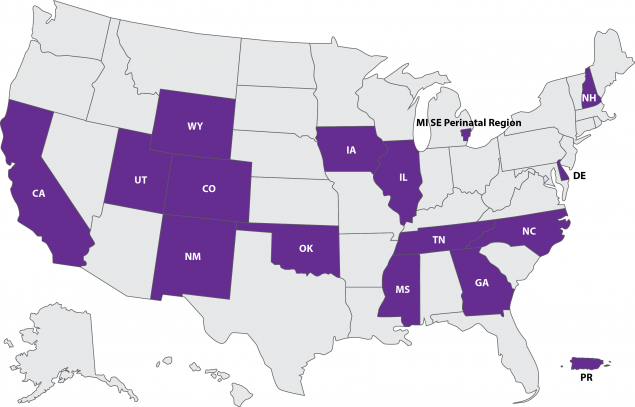Participating States & Success Stories
Participating States
As of February 2019, a total of 15 states (California, Colorado, Delaware, Georgia, Illinois, Iowa, the southeast perinatal region of Michigan, Mississippi, New Hampshire, New Mexico, North Carolina, Oklahoma, Tennessee, Utah, and Wyoming) and Puerto Rico are participating in CDC LOCATe.

Success Stories
Georgia Department of Public Health staff wanted to use LOCATe to compare hospitals’ self-assessment of levels of maternal and neonatal care to national guidelines. In addition, staff aimed to learn about the distribution of resources across the state for maternal and neonatal care. Health Department staff sent letters to all birth hospitals encouraging participation and then emailed the LOCATe assessment link to nursing leadership. CDC analyzed the data and the Georgia Department of Public Health staff provided results to participating hospitals and to a research group to examine the role of level of care among maternal outcomes. As a result of participation in LOCATe, stakeholders working in maternal and infant health started conversations about the need for a standardized state levels of care certification program. In 2018, the GA Legislature passed a level of care bill that established a voluntary program for assessment of levels of care.
The Illinois Department of Public Health was motivated to use LOCATe to compare their state’s perinatal system to the AAP and ACOG guidelines for levels of care. Additionally, staff wanted to use LOCATe results to inform policy decisions to improve care for mothers and infants. Health Department staff obtained buy-in from various stakeholders before proceeding with LOCATe, including Department of Health leadership, nurse administrators that oversee the 10 perinatal centers, and the state Perinatal Advisory Committee. Department of Health staff emphasized the results would be used to evaluate the state system, not to assign levels of care to individual hospitals or for any regulatory/designation purposes. The state perinatal administrators helped distribute the materials to the hospitals and assured survey completion for their network hospitals, resulting in a 100% response rate from the state’s 120 birthing hospitals. Following completion of LOCATe, a state epidemiologist performed several analyses including describing current hospitals’ neonatal and maternal levels of care, the potential impact of changing levels of care to current national guidelines, as well as neonatal mortality across and within levels of care. The findings from these analyses assisted the state of Illinois in the adoption of the current AAP guidelines for neonatal levels of care.
Since 2007, the Department of Health (DOH) in Puerto Rico has worked to assess levels of care of their birth facilities, but discovered the tools they developed were not sufficient. Staff at DOH worked with CDC to translate LOCATe into Spanish and to train the regional directors and health educators to complete the assessment in person at each facility. An analysis of maternal and neonatal outcomes by level of care and by hospital capabilities or protocols was performed. The findings were discussed with each participating hospital and recommendations for quality services according to their level of care was provided. With this information combined with the Maternal and Neonatal Care Guidelines, facilities now have the necessary tools to evaluate their performance and improve their services according to their level of care. The implementation of LOCATe encouraged conversations around emergency preparedness, highlighting the need for inclusion of the maternal and neonatal units in facility protocols and drills and the importance of breastfeeding for mother and infant.
In order to obtain a better understanding of the services available to Utah's mothers and infants, and to ensure that the most vulnerable infants are cared for in the most appropriate facilities, the Maternal and Child Health Bureau at the Utah Department of Health chose risk-appropriate perinatal care as a state priority for their Title V Maternal and Child Health Block Grant. Aided by Utah Administrative Rule and a variety of communication techniques (i.e., sending letters and making phone calls to follow up on hospitals' progress and any questions related to the LOCATe assessment link), state staff were able to achieve a 99% response rate. To help improve outcomes for Utah women and babies, state staff work continuously to build and maintain relationships with nursing and medical directors in the various health systems in Utah. As part of the Department’s relationship with the participating hospitals, a written report of LOCATe assessment results were provided to all participating hospitals in Utah by Bureau staff. As a result of participation and statewide implementation of the LOCATe assessment, the Utah Perinatal Mortality Review incorporates LOCATe levels of maternal and neonatal care into their case review for maternal and infant deaths. Additionally, the Maternal and Infant Program will be developing a report to include maternal complications associated with tertiary and non-tertiary birth locations.